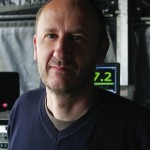
As the Prodigy’s chief live sound engineer, Jon Burton gets to unleash untold kilowatts of bass power on an unsuspecting world. He has also made multitrack recordings of every show on their 26-month world tour.
Credit: TheProdigy.RU Twitter
There’s a lot to be said for having large amounts of loudspeakers,” says Jon Burton. “And big loudspeakers make proper bass noise. There’s no way you can get a good bass sound out of a small speaker, it just doesn’t work.”
For the last two years, Burton has been front-of-house engineer on the Prodigy’s Invaders Must Die tour, a role to which large amounts of loudspeakers and proper bass noise are both absolutely central. When we meet, it’s setup day at the National Bowl in Milton Keynes, where the band are headlining the Warrior’s Dance Festival in front of 65,000 people. The size of the gig has seen the Prodigy’s already massive touring rig augmented by a vast quantity of additional loudspeakers: some quick mental arithmetic from Burton puts the total at well over 400 bass drivers alone (see the ‘National Bowl Setup’ box for details). And as well as setting up and mixing the show, Burton is also making multitrack recordings that will eventually serve as the soundtrack for the videos through which the band connect with their fanbase.
The Midas Touch
Given the sheer scale of the National Bowl gig, not to mention the hi-tech nature of the band’s music, it comes as a surprise to find that Burton’s front-of-house desk of choice is not only analogue, but verging on the vintage. “I’m using a 20-year-old mixing console that cost 10 grand, used, but it’s a classic. This is a Midas XL3, serial number three. It took a pint a year and a half ago at Newcastle and nearly died. It almost lost the show, but it kept struggling through, and it was a three grand repair bill. A bit of the output section no longer works, because you can’t get the chips.
“I’m sorry, but digital doesn’t sound as good as analogue. Also, the Prodigy is more of an old-style reggae mixing gig, in that there’s a lot of echo spun in on vocals, and reaching for things like a bit of snare drum reverb. Which is just a faff to do on a digital desk when you don’t have all the knobs in front of you. There’s quite a lot of effects on the vocals, spin delays and stuff like that, which is partially my style of mixing — I’ve always been a fan of dub reggae and stuff like that — and Maxim [Reality] came from a dancehall background, so he’s well into your reggae reverbs and echoes.
“I do it all by sending stuff from the channel, in that dub style. The most important thing for me doing a gig like this is not being too far away from the stage, because otherwise the time delay gets so long that you can’t do anything in time. You already tend to be working a word ahead, so if I want echo on ‘the echo’, I’ll be putting it on on ‘the’. By the time the sound’s got to me, it’s already so late that by the time I get it on it’ll be on the actual ‘echo’. But after a certain distance you just can’t do it in time.”
![Jon Burton’s desk of choice is a Midas XL3. “My XL3 lived in the Forum in Kentish Town for many years, and has been mixed on by most people I know! It is a right hooker, in that it has the master section on the side, rather than the more recent ones, where it is in the centre. It has been modded with four extra stereo channels, bringing the count to 44 channels. Joe [Campbell, monitor engineer] has the more regular version on stage, and we’re both fans.” Jon Burton’s desk of choice is a Midas XL3. “My XL3 lived in the Forum in Kentish Town for many years, and has been mixed on by most people I know! It is a right hooker, in that it has the master section on the side, rather than the more recent ones, where it is in the centre. It has been modded with four extra stereo channels, bringing the count to 44 channels. Joe [Campbell, monitor engineer] has the more regular version on stage, and we’re both fans.”](http://theprodigyfanboy.com/wp-content/uploads/2011/08/Prodigy_02-150x150.jpg) For these ‘spin effects’, Ableton Live plays a crucial role in Burton’s rig. “Most of my gear is analogue, apart from most of my effects, which are now digital. I did used to have my Space Echo out, but we did too many festivals where it was too dusty, so I use Ableton, and I use VST plug-ins for most of the spin effects. I run Ableton just like an effects unit. I’ve got an RME Hammerfall interface which lives in the back of the rack, and all I do is drop the channel that’s got the VST plug-ins into record, so it routes audio through the VST plug-ins, and then out again as an effect. I just send it out as an auxiliary and back into the desk.
For these ‘spin effects’, Ableton Live plays a crucial role in Burton’s rig. “Most of my gear is analogue, apart from most of my effects, which are now digital. I did used to have my Space Echo out, but we did too many festivals where it was too dusty, so I use Ableton, and I use VST plug-ins for most of the spin effects. I run Ableton just like an effects unit. I’ve got an RME Hammerfall interface which lives in the back of the rack, and all I do is drop the channel that’s got the VST plug-ins into record, so it routes audio through the VST plug-ins, and then out again as an effect. I just send it out as an auxiliary and back into the desk.
“I’m waiting for someone to design a program that does it nicely, but to be honest, Ableton is the most stable. I did try Mainstage, but it doesn’t make sense to me, it seems to be more geared towards MIDI and keyboards, and I can’t get it to do what I want elegantly. Ableton just works. Ableton will do anything other than fall over. It will degrade its audio signal, but it will do anything other than stop doing its job. I’ve got a TC PowerCore which is running some extra plug-ins, to take the pressure off the processor, because I run it quite fast at very low latency.
“I’ve got the excellent Audio Damage Dubstation, and I’ve got a Novation Nocturn controller so I’ve got hands-on control over everything. I’ve got a distortion patch with the Fuzz Plus and one of the Powercore Urei things. I’ve got a harmoniser, a lot of the Audio Damage stuff actually, and one of the TC non-linear reverbs. The dub delay is used on probably half the songs, but other tracks, like ‘Omen’, have got a specific rising feedback harmoniser delay that I’ve got programmed in. I’ve got a falling one, a rising one, some mad ping-pong delays.”
The VST effects are complemented by some tried and tested rackmount units. “The [Roland] Dimension D is used to make the guitar big, because we’ve only got one guitarist and we try to make everything bigger than everything else. I’ve also got a [Yamaha] Rev 7 and a Rev 5. I’ve got them Y-split together because they’ve got a habit of stopping working, so one of them is usually working at any one time. They’re both drum reverbs, I just run them both off the snare. Then I’ve got a guitar reverb, an SPX990, and a [TC Electronic] M2000 on vocals, which does harmoniser on some songs and reverbs on others. Then I’ve got a TC DTwo for all my more traditional delays.”
Coming In Blind
“We’re two years into this tour now, and I think we did a soundcheck on the first show,” says Burton. “We haven’t done one since then.” This is partly because soundchecks aren’t really an option at the festival gigs the Prodigy have been playing lately, and partly because the band are confident that Burton and monitor engineer Joe Campbell can get things right in their absence.
“This desk was EQ’ed initially about a year ago, and I don’t tend to change much, because it’s worked for most shows, and I’ll make adjustments on the system instead. There’s a lot to be said for changing the overall tonal quality of the system to match what you’d expect. I’ll EQ the whole system rather than radically EQ each channel — I’ll turn down the mids, or turn up the bass. Usually, with the Prodigy, I just turn up the bass.”
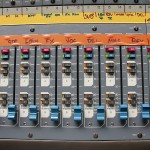
The lack of a soundcheck means that Burton needs to get a working balance fast, as soon as the band arrive on stage. To this end, he typically lines up the individual channel faders at the 0dB level and mixes using the XL3’s VCA groups, which allow him to dedicate a single VCA fader to multiple, musically related channels.“It’s not routing the audio, it’s just using a control voltage to change the audio. I’ll tend to link things musically, so I’ve got all the drums on one, Rob on another, Liam on another. I tend to start the show with the VCAs [all the way down] and just push them up as the band come on. Because at a lot of festivals I’m coming in completely blind. Rob always starts off by wandering on stage playing the guitar and going ‘Woooh!’, so I’ll push that up to about the level I expect to hear it, and then I’ll follow everything else to match that. Liam tends to run just below zero, and by the time I’ve finished the show he’s just above zero.”
As well as huge outdoor festivals like the National Bowl show, the Prodigy’s two-year world tour has also taken in plenty of conventional indoor venues. How hard is it for Jon Burton to make the switch? “There’s not a great deal of difference, really. You’re so much further away [at an outdoor show], it’s a bit like mixing quietly. You have to concentrate, and you have to resist the urge to turn things up, to a certain extent. You have to remember that you’ve got to see the big picture and be really calm, and mix in a calm way. It’s never going to be in your face like it is in a club, and it’s never going to be as loud as it is in a club. It’s a gig in the open air, it’s going to be a bit quieter, and there’s no natural reverberation. It’s very dead-sounding, usually, which can work very well, except that you can get very bad slapback if you’ve got a building behind you. It’s mentally quite different, but it’s still mixing.”
The chance to enjoy such a massive live rig is given to relatively few bands. By contrast, Jon Burton insists that the means by which he makes multitrack recordings of each Prodigy gig are available to all. “The kind of recording we do is the kind of thing that any band could do. It’s just the way you approach it, really. Most desks in clubs you can get subgroups out of. You don’t need them to mix [live], particularly, and even if you do, they’ve usually got a subgroup output. You can take that to your multitrack and just route the subgroup to left and right [to feed the FOH system].
“I’m using every single input and output on the desk to try and multitrack the show. I subgroup the drums together, and because Rob’s only playing bass or guitar, I run those off an auxiliary [to a single HD24 track]. I take a left and right mix as a guide, I use auxiliaries for the vocals and subgroups for all the keyboards, like the main keyboard mixes, I subgroup them all down. You want a certain amount of flexibility, but I’m running it all post-fade, so you tend to be mixing how you want it, to a certain extent, as you go along.
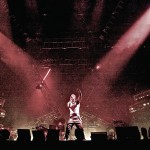
“The most important thing, though, is getting good crowd noise. I think that’s where most live recordings fall down. Obviously, we’ve got a bit more money than most bands, but all I do is I’ve got a couple of microphones on the desk, I use a couple of [AKG] 414s because a condenser’s better than a dynamic, and we’ve got some shotgun mics. For the last six months we’ve been using ones from Thomann, those T-Rack ones that cost 70 quid each. And they sound great! For this gig, Sennheiser have lent us six of the MKH60s, which are about 1200 quid each, and they’re obviously better than the 70 pound ones we have been using — but those have been watched by almost a million people, so you can do it with those.
“Mainly it’s getting two or four sources and then time-aligning it properly so it’s bang on. We’ve got two crowd mics, one either side of the stage, rifles facing towards the audience, which go down the multicore and straight to a Focusrite mic pre. So my mic pre there is just doing all the ambient mics. It’s doing eight channels of ambient mics today, but normally it’s just doing four channels, two out here and two on stage. Everything else, because it’s coming out of the subgroups and auxiliaries on the desk, just goes straight at line level into the HD24.”
Everything is recorded to an Alesis HD24 hard-disk multitracker, to be mixed in Logic in the two or three days of down time that Burton and the band enjoy between weekend festival slots. “I’ll spend a lot of time cleaning up the track and getting rid of spill. I’ll go through and clean up all the vocals, not changing anything, but I’ll hand-draw automation to take all the background noise out and get them as clean as possible. Same with some of the snare hits and stuff like that.”
Working To The Picture
The main purpose behind these recordings is not for a live album or a concert movie, but to provide soundtracks for a series of YouTube videos (www.youtube.com/user/prodigychannel), in which film-maker Paul Dugdale has been documenting the tour for the band’s fans. This, as Burton is quick to point out, makes very different demands on the audio mix. “What people need to do is look at what they’re doing, and see it as part of a bigger picture. You’re not just doing the sound, you’re doing the sound for a video. It’s different from doing an album, different from doing a single. You’re mixing for a different reason, and you’ve got to be working to your picture. The best TV vision mixing guys are the people who are actually watching what’s on the screen and mixing to that. If someone’s doing a trumpet thing, you want to be able to hear the trumpet, to match your eye.
“It all gets sync’ed freehand. There’s no way we can run SMPTE timecode, because a lot of the time, Duggers is haring around the mosh pit with a camera strapped to his head, or standing on stage with a handheld camera. Sometimes we’ll actually use the audio off the camera as well. He’ll take the audio off the camera, it sounds completely distorted, but it’s a vibe thing. The most important thing about audio for video is that you’re not sitting there listening to it, you’re watching the screen. A lot of the time I’ll re-edit the audio to match, so if it goes to a crowd shot, I’ll bump up the crowd there. You’ve got to work with the video to try to make it an all-round experience.”
An all-round experience is, after all, what the 65,000 punters at the Warrior Dance Festival are getting!
The National Bowl Setup
The Prodigy’s monitoring setup alone has the potential to bring down passing aeroplanes, involving, as it does, six D&B dual 18-inch subwoofers, 12 further 18-inch subs, 12 two-way cabinets with a 15-inch woofer and two-inch tweeter, not to mention a further 20 15-inch wedges. “It is,” says Burton, “the loudest thing in the world up there.”
The audience, meanwhile, are served by no fewer than eight full-range line arrays, the main four consisting of 15 L’acoustic Vdosc 15-inch speakers, plus a further two sub arrays of nine D&B J-subs. A horizontal line array of dual 18-inch subs runs along the base of the stage, and just in case that doesn’t provide enough bass, Jon Burton can also call on “infras” — subwoofers for his subwoofers. “The infras are crossing over at about 50Hz. They’re doing 50 down to about 15. They’re a triple 21-inch: a cardioid box with two forward-facing 21-inch speakers and one rear-facing 21-inch speaker.”
In order to provide full coverage, there are also four time-delayed line arrays further out from the stage. “We’ve got delay one, delay two, delay three and delay four, and I think there’s some speakers behind this tent [at the FOH position] as well, because obviously this tent is shielding the main PA. Then we’ve got some little black boxes just underneath the level of the stage, to cover the first three rows at the barrier. It’s very important that everyone who comes to the show can hear it. It’s not just for me, standing here. I’d rather sacrifice the sound here and get it sounding good out there.”
As you might expect, the first step towards getting it sounding good anywhere is to time-align all of the different speaker arrays so they work together. “Because we’ve got such a big keyboard fill in the middle of the stage, if I don’t time-align all the other speakers to that, you get this blurred sound at front of house. Sid Rogerson, who’s my technician, uses SMAART. You put pink noise into one channel of SMAART, and also the PA, then you put a microphone in front of the speaker being measured and that feeds the other side of SMAART. The program then gives you the time delay and distance between the two channels. This way we can align the relative times between each speaker.”
This time-alignment is handled by an 8×8 Midas analogue summing and distribution matrix, which receives four feeds from Burton’s desk: left and right plus separate feeds for the main and ‘infra’ subs. A Dolby Lake system then delays them appropriately and sends them to the various speaker arrays. Once the delay times have been determined using SMAART, Burton fine-tunes the alignment of the various subs. “What I then do is, particularly on the sub, I’ll tweak it using phase rather than delay. I’ll use the Radial Phazers, where you can shift it between 0 and 360 degrees in phase rather than in delay time. It’s never perfect, and requires lots of wandering around and listening. The only way to do it perfectly is to have one really big speaker in the middle of the stage.”
On Stage Mixing

For the National Bowl show, the band have beefed up their usual stage set with a few flying ambulances, but the focus is still Prodigy mainman Liam Howlett’s keyboard setup. Details are shrouded in secrecy, but it is based around Apple MacBook Pro laptops running Ableton Live and Propellerhead Reason. These are joined by an assortment of keyboards, which changes according to Howlett’s whim. “The keyboards come and go. He’ll have a couple of boutique keyboards that he loses interest in and changes for something else, and there’s other ones that he knows he’s always going to want. And then there’s the adapted Space Invaders machine — that’s always going to be there [see box on previous page].”Burton continues: “He’s just taken one of the Roland Gaias, which has fitted in really well, much better for me than that Korg [Monotron] ribbon keyboard — which appeared for one show and was the loudest thing you’ve ever heard. So I’ve got a couple of good compressors on his channels. Nothing’s set in stone, because Liam’s got this nasty habit of changing things all the time. Since he started using Ableton, he’s got the ability to adapt songs on the fly, so there’s lots of non-structured parts in the set where I don’t know what’s going to happen until it’s happened. Which is good — he’s going from strength to strength.”
For live purposes, the Prodigy are a five-piece, with Howlett’s electronics bolstered by two live musicians. “We’ve got Leo Crabtree playing a conventional acoustic Tama drum kit with no electronics, because there’s enough electronics on the stuff that’s coming from Liam, with a selection of scrap metal as well — any odd sounds are things that we found in a skip. Then there’s Rob Holliday playing bass on some songs and guitar on other songs.”
The band’s punishing on-stage levels mean that Jon Burton has to take extreme measures when it comes to miking up the kit. “It’s really, really, really loud on stage. So the overheads are really close, basically a hi-hat and a ride mic, and we’ve got SE Reflexion Filters on those to try to kill some of the sound coming from behind. I’ve got a pair of Hebden Sound mics, which are really good. Because it gets really hot on stage, we’ve got a lot of fans, and they’re really good at keeping out the fan noise. Then most of the mics are built inside the drums, to try to cut down on the spill. We’ve got the Sennheiser 901s in the kick drum and floor toms, and the clip-on Sennheiser mics on the snares.”
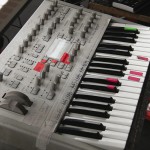
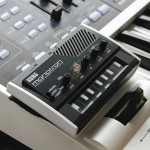

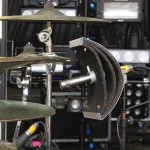
The Prodigy’s brutal on-stage sound levels make conventional drum miking impossible. Burton’s Hebden Sound overheads are positioned very close to the hi-hat and ride cymbals, and shielded with SE Reflexion Filters, while the close mics are mostly built into the drums.
Holliday’s Laney amps are also miked using Sennheisers (the band are endorsees). “We’ve got a selection of vintage [MD]509s — a couple of gold and black ones, a couple of the plain black ones — and some e609s. I think I’ve retired most of the gold and black ones now, as they tend to get kicked over now and again. We’re using those on the guitar, but I’m using Radial DIs now for the bass and the guitar. It sounds great. Because we take it off the back of the amp, we’ve got the Radial amp simulator/DI box and we just plug it straight into the speaker socket. It doesn’t sound quite as good as the mic on the guitar, so I’ve still got a mic on the guitar, and I’ve got a Radial Phazer to trim the phase between the mic and the DI on the guitar.
“Then we’ve got Maxim and Keith on vocals, and they’ve both got three sets of [Sennheiser] G3 radio mics, and we’ve got switchers so they only come down one channel each.
“We just use the preamps in the desk [at the FOH and monitor positions]. The cable run is a problem, but it’s what everyone’s done for years. It’s better if you have an active stage box. I’ve just bought some KT active stage boxes, for the mic splits, which we’ll probably tour next time we go out. But at the moment we’re just on a passive split.”
Mat Davie, Synth Defender
Liam Howlett’s keyboard tech, Mat Davie, is a vital part of the team. As well as maintaining Howlett’s on-stage rig, he built the notorious ‘Invaders Machine’: “The invaders machine is actually a console from a 1984 Defender arcade game. The misnomer came from the album being called Invaders Must Die, and because he used it on the album, it became the Invaders Machine! Inside is a simple siren circuit with two 555 timer chips, modulation speed controlled by the joystick. Also inside is a Catweazle digital fractal one-bit synth, which makes screaming, hideous, old-school digital noises.
“The guitar and drum tech, Peter Sissons, happened to have the Defender console in his garage and thought that it would fit with the style of Liam’s keyboard setup. He donated it to the gig, I added some electronics and it was actually a birthday present for Liam in August 2008. The only other gear I have made for Liam has been MIDI switches and LED lighting, although I am working on modding the Monotrons that Korg have donated to the Prodigy…”
A major part of Davie’s role is keeping Liam’s rig stable on tour. “Maintenance involves backups, cleaning, replacing keys, replacing knobs and sliders, repairing cables, plugs and so on. The only keyboards I have had to repair regularly are the Roland SH101s, of which we have five in total — three grey, one red and one greenish colour. I always have a spare ready, but the keys break, the sliders get worn, the tuning shifts and the power input socket fails occasionally. He is currently trying the new Roland Gaia SH01 as well as the SH101, but his keyboard setup is constantly evolving. The Access Virus is his main keyboard and that is very reliable, but he rides the cutoff knob so I have had to replace that a few times.
“There is a laptop ready to go if one of the other three fail, but we use solid-state drives and they are also very reliable. Liam can do all the mixing from stage, but Jon Burton also has access to the raw outputs from the MOTU 828s in case there is a problem with Liam’s desk.”
Source: http://www.soundonsound.com/sos/oct10/articles/prodigy.htm
